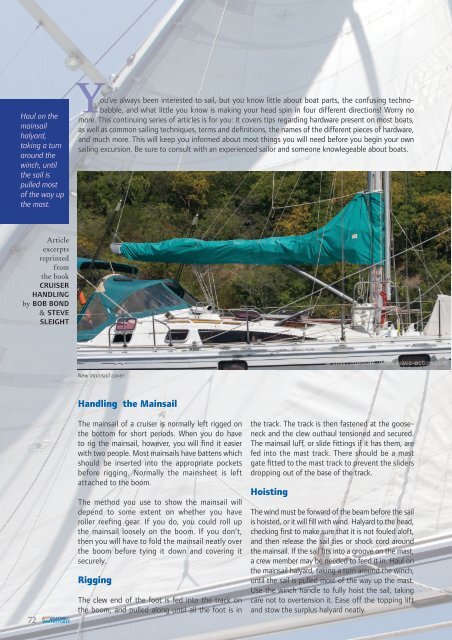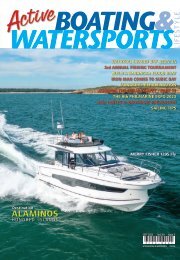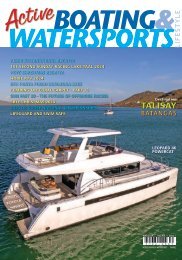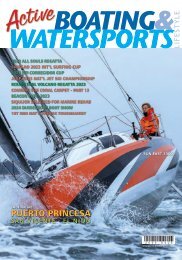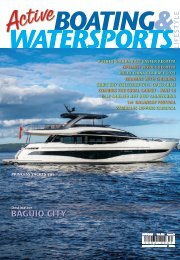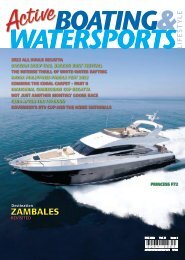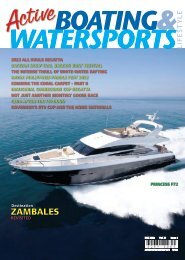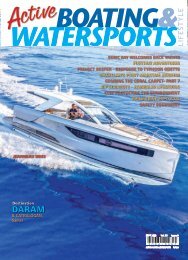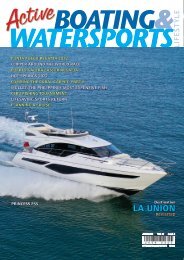ABW June 2016-1
You also want an ePaper? Increase the reach of your titles
YUMPU automatically turns print PDFs into web optimized ePapers that Google loves.
Haul on the<br />
mainsail<br />
halyard,<br />
taking a turn<br />
around the<br />
winch, until<br />
the sail is<br />
pulled most<br />
of the way up<br />
the mast.<br />
You’ve always been interested to sail, but you know little about boat parts, the confusing technobabble,<br />
and what little you know is making your head spin in four different directions! Worry no<br />
more. This continuing series of articles is for you: it covers tips regarding hardware present on most boats,<br />
as well as common sailing techniques, terms and definitions, the names of the different pieces of hardware,<br />
and much more. This will keep you informed about most things you will need before you begin your own<br />
sailing excursion. Be sure to consult with an experienced sailor and someone knowlegeable about boats.<br />
Article<br />
excerpts<br />
reprinted<br />
from<br />
the book<br />
CRUISER<br />
HANDLING<br />
by BOB BOND<br />
& STEVE<br />
SLEIGHT<br />
New mainsail cover<br />
72<br />
Handling the Mainsail<br />
The mainsail of a cruiser is normally left rigged on<br />
the bottom for short periods. When you do have<br />
to rig the mainsail, however, you will find it easier<br />
with two people. Most mainsails have battens which<br />
should be inserted into the appropriate pockets<br />
before rigging. Normally the mainsheet is left<br />
attached to the boom.<br />
The method you use to show the mainsail will<br />
depend to some extent on whether you have<br />
roller reefing gear. If you do, you could roll up<br />
the mainsail loosely on the boom. If you don’t,<br />
then you will have to fold the mainsail neatly over<br />
the boom before tying it down and covering it<br />
securely.<br />
Rigging<br />
The clew end of the foot is fed into the track on<br />
the boom, and pulled along until all the foot is in<br />
the track. The track is then fastened at the gooseneck<br />
and the clew outhaul tensioned and secured.<br />
The mainsail luff, or slide fittings if it has them, are<br />
fed into the mast track. There should be a mast<br />
gate fitted to the mast track to prevent the sliders<br />
dropping out of the base of the track.<br />
Hoisting<br />
The wind must be forward of the beam before the sail<br />
is hoisted, or it will fill with wind. Halyard to the head,<br />
checking first to make sure that it is not fouled aloft,<br />
and then release the sail ties or shock cord around<br />
the mainsail. If the sail fits into a groove on the mast,<br />
a crew member may be needed to feed it in. Haul on<br />
the mainsail halyard, taking a turn around the winch,<br />
until the sail is pulled most of the way up the mast.<br />
Use the winch handle to fully hoist the sail, taking<br />
care not to overtension it. Ease off the topping lift<br />
and stow the surplus halyard neatly.


